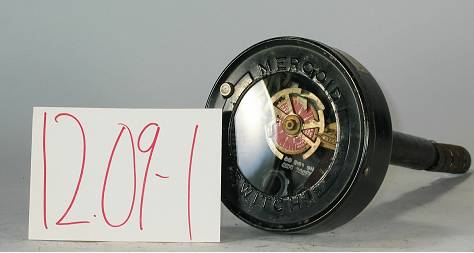Pressure Atomizing Oil Burner Equipment and Systems – High Temperature Limit Controls
A mid 20th century, state-of-the-art, double function, adjustable temperature control for home “winter air conditioner”. Used for automatically shutting down the system to prevent over heating, as well as to star and stop the furnace fan at air temperatures that would help ensure draft free comfort; equipped with helical bimetal heat sensor, twin, tilting mercury bulbs, mechanical brass linkage and manual fan on-off switch, fan and limit control, Type M80, Mercoid, 1938.
Features:
– Temperature calibration dial in red and gold
– Operating, adjustment instruction etched in gold on twin fibreboard insets
– Glass bezel
– Original wiring stubs with steel sheathed cable [BX] and heavy duty L box connectors
Technical Significance:
– A mid 20th century, dual function temperature controller, exquisitely crafted using the materials and engineering know-how of the immediate pre W.W.II years
– Designed for a new, emerging, yet still elite market for winter comfort, the “winter air conditioner”. Mercoid went to great lengths to show off its new, elite, automatic, dual temperature control technology, beautifully crafting with showy glass front panel and mechanical operating mechanism crafted in brass. It was to be a prestigious controller for the homeowner anxious, and able to afford the best that the HVACR industry of the times could provide, anxious too to be able to show it off for what it was, a piece of new technology ahead of its times.
– Air circulation was a matter of engineering concern, ensuring draft free comfort for homeowners not at all used to constantly moving air in the home. The key was the temperature at which the winter air conditioner’s fan would start circulating the pre-warmed air, and at what air temperature would the fan stop
– The manual fan switch was an important sales feature, too, allowing the homeowner to manually turn the system on in the summer time to circulate filtered air throughout the home [For an account of recommended industry practices of the time operation See, “Winter Air Heating and Winter Air conditioning”, John Norris McGraw-Hill 1950.
– It would be a period characterised by much research in the field of human comfort. its necessary and sufficient conditions and the means of creating it in Canada’s climate of weather extremes. Warm air heating research would become a legitimate topic for university, as well as industrial research with technical papers and how-to-do-it manuals to follow.
– Characteristic of the period and the emerging market for winter comfort was the creation of the National Warm Air Heating and Air Conditioning Association of Canada [forerunner of the Heating, Refrigeration and Air Conditioning Institute of Canada]. Their extensive set of engineering manuals produced through the 1950’and 60’s would be the standards of the field
Industrial Significance:
– The control of air movement in forced air, residential systems, to ensure safe comfortable conditions was and continues to be a challenge. With fixed, non modulating, forced air heating equipment, which characterizes the residential field, the control of air movement through the furnace and the home was accomplished with on-off switching of the fan motor. The goal is to ensure the furnace doesn’t over heat, as a result of low air quantity, but at the same time, the householder is not subject to the movement of unheated air through the house causing drafts.
– For the purpose of initially balancing the system, variable speed fan pulley drives were widely used to adjust fan speeds [see collection Group 12.11], until electrically variable speed, digital motor control technology became available.
– Two speed motors with double windings were also used in the 1950′ through 80’s, with two step controller to reduce air flow at low during start up and shut down.


